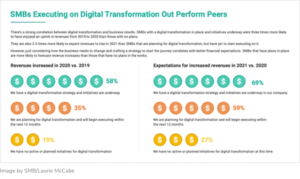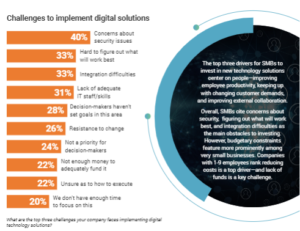The Fog of the Cloud: How do you pick the right technology solution?
Technological advances are constantly changing how we think about things and how
we interact with our work and with others. Yet there is so much buzz around different technologies that it can be overwhelming to navigate through their potential utility and find the best solution for your businesses. Digital Transformation, Artificial Intelligence, Augmented Reality, Virtual Reality, Machine Learning… it’s been coming at us from every direction recently, hasn’t it?
 So let’s cut straight through the fog. Ultimately the decision to invest in technology should be based on the answers to two questions:
So let’s cut straight through the fog. Ultimately the decision to invest in technology should be based on the answers to two questions:
- Does the solution make you more resilient
- Does the solution make you more money
Why the right solution makes you more resilient
Small and medium-sized businesses (SMBs) have attracted a lot of attention from technology providers that are looking to provide us with the most feature rich and state-of-the-art solutions. That is no surprise, because 99.9% of all businesses in the US are SMBs and according to the Small Business Administration, we employ 47.1% of the private sector workforce.
There is a widespread and intimidating misconception that large businesses have inherent advantages when a crisis hits, whether it is the pandemic, inflation, supply bottlenecks, or another cause. The thinking is that large firms are more resilient because they have more employees, more technology, more spending power, and more cash on hand.
But their resilience is often an illusion.
True resilience comes from the ability to adapt and change, not from the ability to simply endure a crisis until the tide turns. Large businesses tend to take much longer to make decisions, and even longer to implement them. They drown in data from multiple departments that often conflict with each other. They may endure a crisis, but they rarely emerge better and stronger on the flipside. That is where SMBs have an advantage, because a crisis forces us to work smarter, not harder. Ultimately, our ability to identify our challenges — and then make quicker decisions to manage through them — will give us the competitive edge we want.
 For this to happen, we must be able to see the challenges as soon as they are starting to arise and to be able to take actions to address them. This is where technology is critical to our success.
For this to happen, we must be able to see the challenges as soon as they are starting to arise and to be able to take actions to address them. This is where technology is critical to our success.
To run our businesses most effectively, we need to fully understand our cost and revenue drivers, from both a financial and volume perspective. We need to know about changes in those drivers at the earliest possible moment. With appropriate tech tools in place,
SMB employees can slice and dice data which might take weeks or months to acquire in larger businesses. While it might appear that larger enterprises have “better” systems in place, many of those systems exist purely to process huge volumes of transactions. They potentially have less ability to provide actionable insights than solutions that are available to the SMB sector.
There is plenty of evidence to point to the fact that SMB businesses have an amazing opportunity to win with the right technologies in place. Let’s remember that “there are no problems, only opportunities in disguise”.
How the right solution makes you more money
Several statistics demonstrate how businesses that have made investments in technology are reaping dividends. The correlation between technology investment and revenue growth cannot be overstated. The following graphic from SMB Group demonstrates this correlation:

Savvy SMBs are also constantly innovating to provide new means to allow customers to experience their products. Whether those experiences are virtual house tours, online vehicle configurators, 3D renderings of products, gamification of employee onboarding sites, or the medical profession’s use of augmented reality, SMBs are constantly finding new ways to engage customers.
But I have concerns about investing in technology…
As noted earlier, there are a great many different technologies available and limitless ways that SMBs can apply them to their businesses. An investment in technology should be evaluated as an investment in the future state of your business, an asset which can continue to provide value. It is not for the here-and-now.
For your business to remain adaptable to change, your technology must be future — proof and empower your flexibility for the foreseeable future.
Some notable concerns that are cited about investment in technology include:

Finding the right solution for you
Bakerfield Solutions has worked with hundreds of different businesses. We have developed a methodology to identify where proposed projects are appropriate for an organization and if those projects can provide the anticipated outcomes. We have named this simple methodology ENDCO, consistent with our primary tenet of always keeping the end-company in mind.
- Executive strategy is critical to the decision to pursue any project. Ultimately it will be the executive group within an organization that will determine if a project has been successful. They will look if the project has been delivered on budget and on time. They will confirm that it helps them monitor key drivers in the business to support their decision-making regarding the direction for the business.
- Needs of the business should always be identified at all levels. Almost every project will provide gains in functionality and efficiency, yet realistically some losses as well. Bakerfield Solutions works diligently to ensure that no stone is left unturned and to maximize our customer satisfaction in terms of our project outcomes.
- Due diligence should be conducted to vet any prospective solution and its provider. It is important to review success stories regarding the proposed solutions demonstrating that customers have been happy with the outcomes. Ensure that the pricing policy of your candidate providers is clearly defined for the next 10-12 years and that you cannot be susceptible to hidden price hikes, poor customer service, costly and frequent upgrades or having to do most of the work yourself because your contract doesn’t make responsibilities clear. It is entirely possible that a solution that purports to deliver you a technology advantage is built on outdated technology, so be sure to engage technology experts in your due diligence.
- Contingency planning will help to define your options if the project fails or is delayed for any reason. It will also help determine who is responsible for restitution, should it become necessary. It’s a good idea to manage the implementation of the new technology at a time that is least impactful to employees and customers.
- Organizational change will undoubtedly arise because of the technology project. Be sure to make adequate provisions for employee retraining and for involvement in the change process as it pertains to their part of the business. This will help minimize employee resistance to change, maximize adoption of the new technology, and optimize its use. Employee engagement is critical to your level of customer service and ultimately to your revenue. Employees need to feel valued and that they are important, because they are!
Any technology solution should be evaluated to determine that it is:
- Future proof
- Able to facilitate remote collaboration
- Capable of being quickly integrated with other systems and in a consistent manner
- Able to provide several functions from a common solution
- Resilient itself
